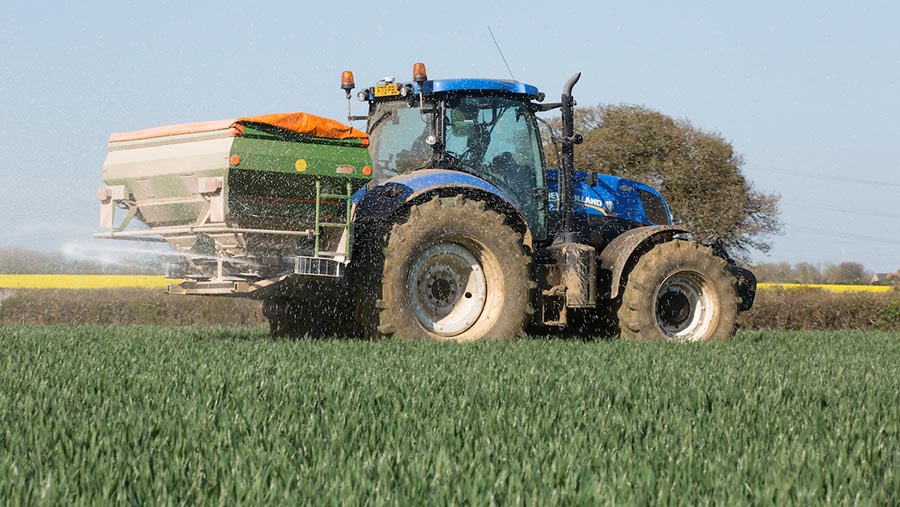Four farmers’ plans to cope with soaring fertiliser costs
 © Tim Scrivener
© Tim Scrivener The recent hike in fertiliser price has seen production costs skyrocket for arable farmers. We speak to four farmers from across the country to find out what this means for their business and how they are dealing with the unprecedented price jump.
See also: Video: Hands-Free Farm turns to drilling after good harvest

© Roger Wilson
Roger Wilson, Lower Odd Farm, Wiltshire
With no fertiliser stocks on farm, Wiltshire farmer Roger Wilson plans to cut applications by 60kg N/ha across his winter wheat crops at Lower Odd Farm.
After the initial panic from the shock price rise, Mr Wilson now sees the fertiliser price as an opportunity to reduce inputs, improve N efficiency and cut back on fungicide spend.
“Perhaps this will be a wake-up call to farmers which will make us stand back and think about what we do, what we spend and how much we apply,” he says.
Mr Wilson usually purchases three loads of nitrogen fertiliser a year, but this year he has ordered just two, which he plans to use as efficiently as possible.
“Given the price rise, we have worked closely with our agronomist to reduce nitrogen rates from 220 to 160kg N/ha, which is a significant cutback.”
Limited storage on farm for fertiliser means he finds it difficult to purchase nitrogen early in the season.
But with plans to reduce the amount of nitrogen applied, there is scope to reduce the fungicide spend of the four-spray approach. The intention is to drop the T0 spray, and leave tebuconazole as the mainstay fungicide at the T1 and T3 timings due to its lower cost.
“It will be interesting to see how things fare this season. Our winter wheat yields can hit 10t/ha, but the rolling farm average is 8.5t/ha. This year we are budgeting for 7.5t/ha,” says Mr WIlson.
Beans and cattle in the rotation (peaking at 120 beef cattle on farm), also help mitigate against pricing challenges by reducing reliance on artificial fertiliser.

© Gillian Pitt
Ian Pigott, Thrales End Farm, Hertfordshire
Hertfordshire grower Ian Pigott was forced to rethink his cropping plans and significantly reduce his second wheat area, after spiralling growing costs left the crop unviable.
Some 20% of this year’s rotation was earmarked for second wheat, but soaring fertiliser prices have meant just 6% will be planted with second wheat. Mr Pigott questions if this is still too much.
Fortunately, he purchased a proportion of his annual fertiliser requirement in May, but in mid-October was quoted a staggering £770/t for ammonium nitrate. He is also concerned that his order of urea may not be delivered due to supply chain issues.
“It makes no sense to grow second wheat with fertiliser at £770/t. We’re already running a no-till low-input system across our marginal Grade 3 land, so there is limited leeway to reduce inputs further,” he says.
Despite this, nitrogen rates are set to be cut back from the usual 175-195kg/ha for first wheats, (depending on soil type) and 185-210kg/ha for second wheats.
“We certainly won’t be applying three large doses of nitrogen, and instead maybe four or five reduced rate passes.”
He is also considering foliar nitrogen sprays to improve efficiency.
Land not planted to second wheat has instead been sown to black oats that will be used either as a cover crop or taken through to harvest as home-saved seed.

© Jim Varney
Angus Gowthorpe, Approach Farm, Yorkshire
A foliar amide nitrogen spray is set to play a key role in Yorkshire farmer Angus Gowthorpe’s crop nutrition programme, given the spike in fertiliser costs.
Running a 160ha low-input mixed farm in the Vale of York which focuses on soil health, livestock integration and regenerative agriculture, a total of 150kg/ha of nitrogen is applied to winter wheat.
After pleasing trial results using the spray last year, which saw 75% less N/kg used compared to a standard fertiliser application, Mr Gowthorpe now intends to use the product across his total 50ha wheat area.
Three-quarters of total nitrogen will now be obtained from the spray in two to three applications, compared with just one-third of total nitrogen in the trial last year.
The remaining quarter will be made up of one standard solid urea sulphur application, which will be applied first.
The foliar spray contains an amide complex which increases the uptake and efficiency of crop trace elements. Also containing carbohydrates, it encourages faster crop emergence and the growth of beneficial micro-organisms.
“The nitrogen in the spray is in a more readily available format to the plants, meaning it has significantly better efficiency than standard fertiliser. What’s more, spraying directly on the leaf increases application accuracy, so it can be used in drier conditions,” says Mr Gowthorpe.
Livestock also play a hugely important role on the farm, where other crops include both winter and spring barley, spring oats and spring beans.
Applications of farmyard manure from his 42 pedigree Saler suckler cow herd and incorporation of herbal grazing leys into the arable rotation significantly reduce reliance on artificial fertiliser inputs.
“Mob grazing of the herbal leys helps improve soil health, where following winter wheat crops see yield increases of 20%,” he says.
Mr Gowthorpe also purchases green waste compost to improve soil organic matter, and for the first time this year will grow maize for a local anaerobic digester plant in return for nutrient rich digestate.
Due to the improvements of soil health and focus on regenerative agriculture, no insecticide sprays are applied and just one fungicide was applied to last year’s wheat, 10 days after the T3 timing due to an influx of yellow rust.

© Tim Scrivener
Will Oliver, Swepstone Fields Farm, Leicestershire
For Leicestershire farmer Will Oliver the recent fertiliser price hike means he will be particularly careful with nitrogen applications and operate a greater reliance on organic manures and digestate.
Fortunately, he purchased enough fertiliser to cover his winter wheat area before the price rocket, but with such volatile markets he intends to make the most out of spring applied poultry manures from his 180,000 bird broiler unit.
In previous seasons, this saved him £26,600 in ammonium nitrate costs at Swepstone Fields Farm, but this figure is now only set to climb.
He has enough manure to cover one-third of his 800ha of arable cropping, growing winter wheat, maize and beans, across mainly clay/loam soils.
“Applications are made precisely, using the farm’s weighbridge, so we know exactly how much to apply,” he says.
Last year, winter wheat crops received poultry manure in the autumn and spring and their yields were compared, with wheat crops treated with spring-applied manure being the highest yielding.
However, he admits that applications are heavily dictated by travelling conditions, more so than standard fertiliser applications due to heavier machine loads, which is why dry conditions are so necessary.
The remaining two-thirds of land will be applied with bought-in digestate, while a hand-held N-tester will be used.
“From February onwards, we will take weekly tissue samples to test nitrogen levels in crops, to closely monitor N levels to tailor nutrition programmes to crop needs,” he says.

